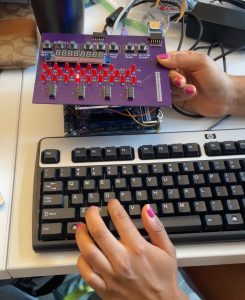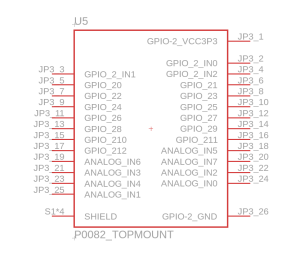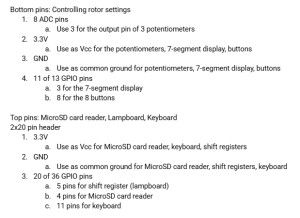This week, I mainly worked with Tanisha on the layout of the PCB. We finalized some of the arrangement of the PCB (such as moving the buttons and rotary encoder to be above the 7 segment displays) as our parts started to come in and we could get a sense for how they would fit together on top of the FPGA. Once these decisions were finalized, we were able to start thinking about how best to format our silkscreen and other aesthetic choices so that users could easily use our product and for it to be more historically accurate.

Above is our most recent PCB layout, with a single rotary encoder on top, 8 buttons to control the 8 seven segment displays, and the display underneath it. The microSD card reader pins are to the right and the lampboard is underneath the buttons. There are four shift registers to cover the many outputs of the lampboard, and the DE10 header is on the bottom right.
Additionally, Amelia and I met to discuss the plan moving forward on the RTL now that she had successfully implemented the PS/2 protocol. She also caught me up on what I had missed when I was sick on Wednesday, and we had our ethics discussion as a team after that. We decided that the most pressing issue after the PS/2 was to ensure that the microSD card protocol worked as well.
However, after the issues we had with our PS/2 keyboard (see the team status report), I started to worry that we may have the same problem with our microSD card reader, since it requires 5V. While there is a 5V source pin on the FPGA GPIO header, all of the GPIO pins are 3.3V logic, and we do not want to provide too much voltage to the pins. After looking at the Amazon reviews and description of the microSD card reader, it still seemed ambiguous if it could function with both 3.3V and 5V, as the reader does step down the 5V to 3.3V internally. I plan on testing the reader now that it has been delivered to see what the idle voltage of the MISO line is, and hopefully it is 3.3V. Otherwise, we may have to explore other ways to regulate the voltage.
Next week, I will focus on the microSD card functionality. This includes verifying that the reader will work with 3.3V so that we can finalize this on our PCB, and then I will move onto implementing SPI protocol for the microSD card in RTL. Our PCB is moving along nicely, and I will help Tanisha with the traces as needed. Overall, we are on track, especially since the keyboard issue resolved itself with Amelia’s hard work!



